The Australian consumer and the broader industry’s traditional heavy bias towards hindquarter beef cuts is beginning to change, driven by new and evolving culinary trends, and the gradual shift towards becoming a more multi-cultural society.
The trend was highlighted during a detailed exploration of forequarter meat prospects presented during the recent Australian Wagyu Association conference held in Geelong.
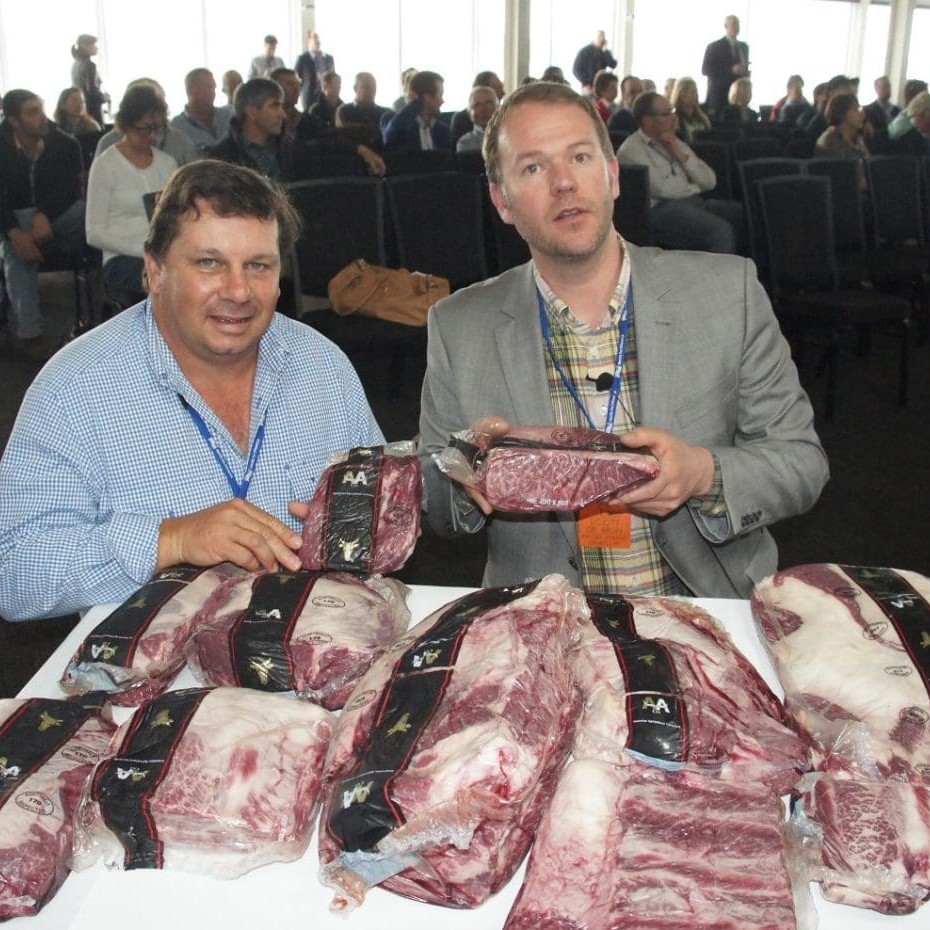 Providing the commentary was newly-elected president of the Australian Wagyu Association, Scott de Bruin, who manages his family’s Mayura fullblood Wagyu beef supply chain near Millicent in South Australia. The de Bruins breed, grow, lotfeed, slaughter and market their Mayura Wagyu into a host of international and domestic markets.
Providing the commentary was newly-elected president of the Australian Wagyu Association, Scott de Bruin, who manages his family’s Mayura fullblood Wagyu beef supply chain near Millicent in South Australia. The de Bruins breed, grow, lotfeed, slaughter and market their Mayura Wagyu into a host of international and domestic markets.
“Traditionally, in the Australian beef industry, we’ve always had a focus on the hindquarter,” Mr de Bruin said.
“Commentary among cattle breeders often talks about breeding cattle for hindquarter characteristics, where the perceived value in cuts is.”
“When my family was originally breeding Angus cattle, that’s certainly what we aimed to achieve, but the transition into Wagyu brings quite a different shift in mentality,” Mr de Bruin said.
“Suddenly, forequarter takes on a much higher priority, as in traditional markets like Japan and Korea, forequarter meat is much more prized by consumers, and the trend is now happening here.”
Just one of the reasons for this was development of cooking styles from different parts of the world to better utilise more of the carcase. Japanese yakiniku style and Korean barbecue restaurants are commonplace overseas and becoming increasingly so in Australia, and both rely almost exclusively on forequarter meat.
Allied with this, the penetration of the Wagyu industry in Australia was now significantly improving the eating quality of some secondary/forequarter cuts, elevating them into a different eating quality performance, and value category.
The discussion during the AWA conference took place around a display of cryovaced chilled forequarter cuts taken from a F1 marbling score 5 animal produced by the Australian Agricultural Co.
“This, to me, is where the potential value really is in a Wagyu-influenced carcase,” Mr de Bruin said.
He then discussed in detail a list of 15 different forequarter cuts taken from the F1 carcase, including some ‘non-traditional’ items that could be utilised in different ways, because of the abundance of marbling and enhanced eating quality.
“Traditionally when then industry thinks of forequarter it thinks of stewing, braising, grinding or roasting. But a Wagyu animal going through a typical longfeeding program costs so much to produce, we really need to think about utilising each of those individual forequarter cuts to best advantage.”
“What’s often found is that as the marbling increases through a Wagyu animal, it doesn’t matter what the forequarter cut is – many of them can be grilled,” he said.
Additionally, the degree of marbling is typically higher in forequarter Wagyu meat than it is in hindquarter cuts.
“And many forequarter cuts have very unique flavour, and have outstanding tenderness. Many are close to the bone, and as everybody knows, meat close to the bone often has the best flavour.”
Of the 15 forequarter sub-primals discussed, many would simply go into trimmings, if harvested off conventional cattle, he said.
Some of the 15 items discussed included:
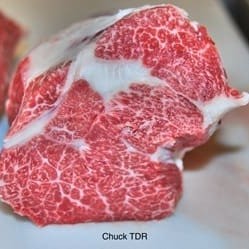 Chuck tender: In Wagyu carcases, the high level of marbling present lifts the eating quality of a typical chuck tender considerably. “It is traditionally used in stews or slow cooked preparations, but cut thin from a Wagyu carcase, it can be grilled or cooked in Japanese yakiniku style. Thin slicing is widely used in Asian markets to lift tenderness and add value to the whole carcase.”
Chuck tender: In Wagyu carcases, the high level of marbling present lifts the eating quality of a typical chuck tender considerably. “It is traditionally used in stews or slow cooked preparations, but cut thin from a Wagyu carcase, it can be grilled or cooked in Japanese yakiniku style. Thin slicing is widely used in Asian markets to lift tenderness and add value to the whole carcase.”
Bolar blade: Again bolar blade has typically been used in the Australian beef industry for roasting, stir-fry and similar applications. But because of the high concentrations of marbling in a Wagyu blade, its tenderness lends itself to other applications. It can be thinly sliced or cubed and put on a grill. It tends to lose volume as a braised item.
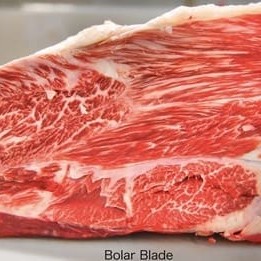 Oyster blade: has become very popular in the food service sector over the past 18 months. Sometimes described on menus as a flat-iron steak, the oyster blade with the central connective tissue removed is now a popular steak item, particularly from a larger, more heavily marbled Wagyu carcase (see comments on carcase size below).
Oyster blade: has become very popular in the food service sector over the past 18 months. Sometimes described on menus as a flat-iron steak, the oyster blade with the central connective tissue removed is now a popular steak item, particularly from a larger, more heavily marbled Wagyu carcase (see comments on carcase size below).
Chuck roll: Still widely used for mince or braising, but has application in Japanese food styles like shabu shabu or yakiniku, used instead of striploin, as well as thin slicing or cubes for grilling, again creating a lot more value.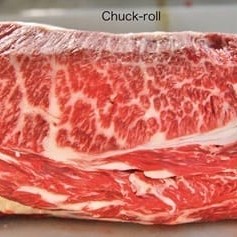
Chuck rib meat: separated from the chuck roll, rib meat is highly prized and valued by the Japanese for yakiniku, but in Australia often ends up in sausages or trim. “Recently we served Wagyu rib-meat as steaks to get some feedback from consumers, and they said they had never had such wonderful steak – and remember this is out of the chuck primal,” Mr de Bruin said. “There’s a real premium available for these cuts, and as Australia goes through different trends we’re seeing more of that value extracted.”
Karubi plate: Extracted from the brisket, again a very high quality cut carrying an abundance of marbling. Briskets are traditionally rolled by the butcher as a roast. Karubi plate can be grilled whole and thinly sliced or sliced first for grilling, yakiniku style. “The flavour from many of these secondary cuts is quite unique, and has its own value,” Mr de Bruin said.
Inside skirt: While a thinner cut and quite small in size, it still has additional value from a Wagyu animal, especially in food service where it can be used for grilling, beef salads and similar applications.
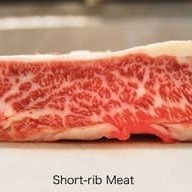 Shortrib meat: While it has been popular in Australia for a long time, again mostly for braising and similar applications, the more marbled version from Wagyu, pictured here, can easily be used for grilling, thin slicing and barbecue.
Shortrib meat: While it has been popular in Australia for a long time, again mostly for braising and similar applications, the more marbled version from Wagyu, pictured here, can easily be used for grilling, thin slicing and barbecue.
Flank steak: Again, growing in popularity, Wagyu flank meat has very high quality eating characteristics, and can be thin-sliced.
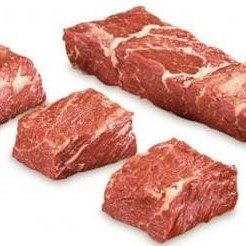 Flap meat: while it is not the most appealing looking piece of meat in its raw form, flap meat from Wagyu is extremely soft and tender, and has applications in grilling and barbecue.
Flap meat: while it is not the most appealing looking piece of meat in its raw form, flap meat from Wagyu is extremely soft and tender, and has applications in grilling and barbecue.
Chuck tail flat: Mr de Bruin urged AWA delegates to try it if they did their own kill at home, as it was “one of the best eating quality steaks you’ll ever have.” “It’s another terrific testament to the eating quality of Wagyu – again you do not see this sort of product sold through domestic wholesalers or supermarket style beef, but the additional eating quality provided by Wagyu makes it possible, with a good eye in it and lots and lots of marbling. It’s not quite like eating a tenderloin, it has a little more bite to it, but it has a whole lot of flavour.”
Point-end brisket: One of the only forequarter cuts not suited to thin slicing and grilling, the brisket has been very popular for a long time in the US, and increasingly so in Australia, for smokey Texas barbecue pulled brisket preparations. It can be used on both food service and home cooking applications, slow-cooked in a Webber.
For the reasons discussed above, forequarter meat added significant value to a Wagyu carcase, relative to conventional breeds, Mr de Bruin said.
“It’s about moving away from traditional applications and methods, shifting more of the carcase into a vacuum-pack than simply selling it as manufacturing meat.”
“Taking out the loin cuts and the trim, the forequarter is worth 80 percent more than the hindquarter in value,” he said.
“That’s a significant amount of money, when the Australian industry for years has been educated the other way around.”
During questiontime, Beef Central asked Mr de Bruin whether the sheer size of Wagyu carcases at the end of a 350-500 day feeding program – typically 450-550kg carcase weight, provided greater opportunity to harvest more of these smaller, thinner sub-primal muscles.
“There’s about 32 individual muscles or sub-primal cuts that can be taken from a carcase, which is quite a lot – but as the carcase gets bigger, they certainly become a lot more usable and user friendly. Certainly a lot of these cuts, from lighter weight carcases, are so small they’re not worth worrying about. In some cases, it’s possible to do a bone-in version, such as shortplates, which creates a bit more volume.”
“But as the carcase gets bigger, it starts to increase the rib-thickness which is a very important aspect, because the other cuts around the rib cage start to get a lot thicker, also, and a lot more versatile,” he said.
“The other aspect is that in the quest to produce lots and lots of marbling, Wagyu on longfed programs also produced a lot of fat. When the sub-primals are taken out and trimmed, they do carry a lot of fat. When you’re doing high-value Wagyu carcases, with the trim, you can be talking 45-50CL (chemical lean).”
“So the more cuts you can put through a process like this, increasing their grilling value, over being sent to the grinder, is really important.”
Even in some of the butt cuts, it was possible to break down a primal like a knuckle further, extracting the centre cut, which ate beautifully as a grilling steak.
“There’s lots of opportunities like that, The topside, again, can be thinly sliced and grilled. But it does have a bit more ‘bite’ to it. The message is, that with those high quality marbling score 9 type carcases, you can pretty much thin-slice and grill the whole carcase, and get a great eating result.”
“The Japanese have made a fine-art of doing that. One of the reasons why they are able to pay $20,000 or more for a high marbling carcase is that they can get so many grilling serve portions out of it, not having to send big lumps to the mincer.”
“The principal applies also, to a lesser extent on marbling score 7-8 cattle, but especially so with the 9+ cattle.”
